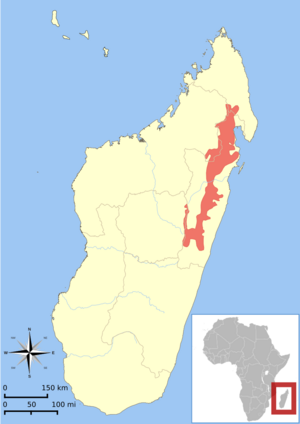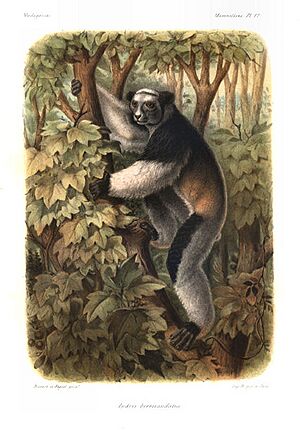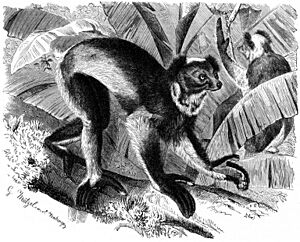Babakoto facts for kids
Quick facts for kids Indri |
|
|---|---|
 |
|
| In Analamazaotra Special Reserve | |
| Conservation status | |
| Scientific classification | |
| Genus: |
Indri
|
| Species: |
indri
|
 |
|
| Distribution of I. indri | |
| Synonyms | |
|
Genus:
Species:
|
|
The indri (pronounced IN-dree), also called the babakoto, is one of the largest lemurs living today. It makes its home in the forests of Madagascar. This amazing animal can grow to be about 64 to 72 centimeters (25 to 28 inches) long. It weighs between 6 and 9.5 kilograms (13 to 21 pounds).
Indris have striking black and white fur. They often sit upright when climbing or resting in trees. Indris live in small family groups and usually stay with one partner for life. They spend their days moving through the treetops. They mostly eat leaves, but also enjoy seeds, fruits, and flowers.
These lemurs are very noisy! They sing, roar, and make other sounds to talk with other indri groups. Besides humans, the indri is the only mammal known to use rhythm in its calls. Like all lemurs, it is only found in Madagascar. Local people, called the Malagasy people, respect the indri. It appears in many of their myths and legends.
Sadly, the indri is in danger. Its home is being destroyed by farming and cutting down trees. People also hunt indris, even though there are local rules against it. Because of these threats, the International Union for Conservation of Nature says the indri is "critically endangered".
Contents
What's in a Name?
The name "indri" probably comes from the Malagasy word endrina. There's a common story that the name came from a misunderstanding. A French scientist named Pierre Sonnerat was the first to describe the animal. He supposedly heard a Malagasy person point and say indry, meaning "there it is." Sonnerat thought this was the animal's name.
Another Malagasy name for the indri is babakoto. This name often means "ancestor" or "father." Some people translate it as "father of a little boy." This fits with many local stories about how the babakoto came to be.
How Does the Indri Look?
The indri is one of the largest lemurs still living. It usually weighs about 6.5 kilograms (14 pounds). Some can weigh up to 9.5 kilograms (21 pounds). When its legs are stretched out, it can reach almost 120 centimeters (4 feet) tall.
Indris are known for clinging to trees and leaping. This means they hold their bodies straight up when they move or rest in branches. They have long, strong legs that help them jump from tree to tree. Their large green eyes and black face are framed by soft, round ears. Unlike most other lemurs, the indri has only a very short tail.
Its fur is silky and mostly black. It has white patches on its arms, legs, neck, head, and lower back. The amount of white can be different depending on where the indri lives. Some indris in the northern parts of Madagascar are almost completely black. Their faces are bare with pale black skin, sometimes with white fur around them.
Indri Behavior
Indris usually stay with one partner for their whole lives. They only find a new partner if their mate dies. They live in small family groups. These groups include the male and female parents and their young.
Like many lemur species, indri groups are led by the female. The dominant female often makes males move to lower branches or places with less food. She is usually the one who leads the group when they travel.
Indri groups typically travel about 300 to 700 meters (980 to 2,300 feet) each day. They travel more in mid-summer when they are looking for fruit. Indris sleep in trees, usually 10 to 30 meters (33 to 98 feet) off the ground. They often sleep alone or in pairs. Young female indris sometimes play wrestle quietly for a few minutes. All members of a group will use the same special spots in their territory to go to the bathroom.
Family Life
Indris are ready to have babies when they are between 7 and 9 years old. Females usually have one baby every two to three years. The baby grows inside the mother for about 120 to 150 days. Babies are usually born in May or June.
The mother takes care of the baby most of the time. However, the father also helps by staying with his mate and offspring. Baby indris are born mostly or completely black. They start to get their white fur (if they have any) when they are four to six months old.
A baby indri holds onto its mother's belly until it is about four or five months old. Then, it moves to her back. The indri starts to become more independent at eight months. But it won't be fully on its own until it is at least two years old.
Talking and Singing

The indri is famous for its loud, special songs. These songs can last from 45 seconds to over 3 minutes. The length and pattern of the songs can change between groups. But most songs follow a three-part pattern.
First, there's usually a roaring sound that lasts for several seconds. All indris in the group, except the very young ones, join in this roar. After the roar, the adult pair sings a long note sequence. These notes can last up to five seconds. Finally, there's a descending phrase sequence. The sounds start high and get lower in pitch. Often, two or more indris will sing their low notes together, creating a duet.
Different indri groups usually sing one after another, responding to each other. These songs help groups connect. They also show who owns what territory. Indris might sing after hearing thunder, airplanes, bird calls, or other lemur sounds. A group will sing almost every day, sometimes up to seven times a day. They sing most often between 7 and 11 in the morning. They sing more frequently during their breeding season, from December to March.
Indris also make other sounds. They use a "roar" to warn about predators from the sky, like hawks. They make a "hoot" or "honk" to warn about predators on the ground, like the fossa. Other sounds include grunts, kisses, wheezes, and hums. Scientists are still trying to understand what these sounds mean.
Before they sing, indris move to the tops of the trees. This helps their songs be heard up to 4 kilometers (2.5 miles) away!
What Do Indris Eat?
Indris are herbivores, meaning they eat plants. They mostly eat leaves, especially young, soft ones. But they also enjoy seeds, fruits, and flowers. Female indris seem to like young leaves more than males do. They spend more time looking for them. Indris eat many different kinds of plants. Plants from the laurel family are a big part of their diet.
To eat, an indri pulls off a leaf or other plant part with its teeth. It uses its hands to pull tree branches closer to its mouth. Female indris who are old enough to have babies get to eat first. This means they often find food higher up in the trees than the males.
Where Do Indris Live?
This lemur lives in the lowland and montane forests along the eastern coast of Madagascar. You can find them from the Réserve Spéciale d’Anjanaharibe-Sud in the north down to the Mangoro River in the south. They are not found in the Masoala Peninsula or the Marojejy National Park.
Indris and Humans
Myths and Legends
Across Madagascar, the indri is respected and protected by special rules called fady. There are many different stories about how the indri came to be. But all of them say it is a sacred animal that should not be hunted or harmed.
One legend tells of a man who went hunting in the forest and never came back. His son worried and went to look for him. When the son also disappeared, the other villagers went into the forest. They found only two large lemurs sitting in the trees. These were the first indris. The story says the boy and his father had turned into them. In some versions, only the son changes. Then, the wailing sound of the babakoto is like the father crying for his lost son.
Another human-like thing about the indri is how it acts in the sun. Like its sifaka relatives, the indri often "sunbathes." As the sun rises each morning, it sits facing the sun from a tree branch. Its legs are crossed, its back is straight, and its hands are low with palms facing out or resting on its knees. Its eyes are half-closed. Many Malagasy people believe that the indri worships the sun.
Saving the Indri
The first film of indris was made using special sounds to attract them. This happened during an expedition for David Attenborough's 1961 BBC series Zoo Quest to Madagascar.
The indri is a critically endangered species. This means it is at a very high risk of becoming extinct. While it's hard to know exactly how many there are, their numbers are dropping fast. The population might shrink by 80% in the next 36 years. The biggest dangers to indris are the destruction and breaking up of their homes. This happens because of slash and burn farming, collecting firewood, and logging. This destruction happens even in protected areas.
Indris are also hunted a lot. This is despite the many myths and traditional rules (fady) that say they are sacred. Changes in culture and people moving to new areas are partly to blame for these old beliefs breaking down. Sometimes, people who don't like the protective fady find ways around them. People whose fady forbid them from eating indri might still hunt them and sell their meat. And those forbidden to kill indris might still buy and eat them. Indri meat is seen as a special food in some places.
Only one indri has ever lived for more than a year in captivity. None have successfully had babies while in captivity. This makes it very hard to help them by breeding them in zoos.
Images for kids







